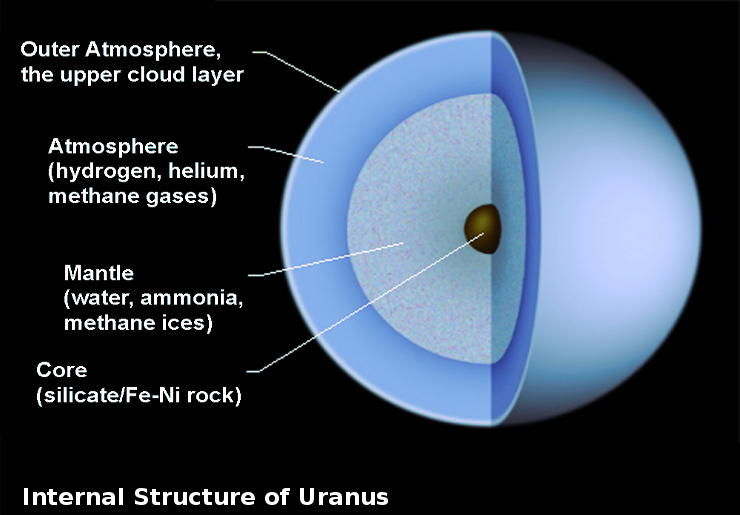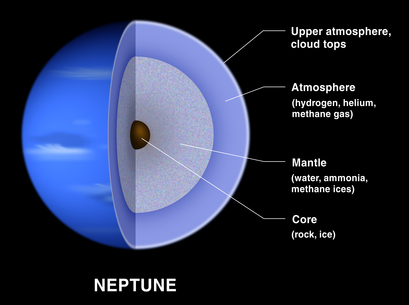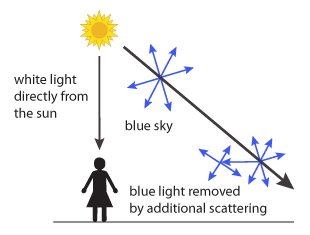In this week’s discussion topic, I attempt to answer the question “Why are Uranus and Neptune distinctly bluer than Jupiter and Saturn?”
On Uranus and Neptune, the methane absorbs red, orange and yellow light, reflecting back the blue. In contrast, Jupiter and Saturn have only minor trace amounts of methane and quite a bit more hydrogen and ammonia.


The resolution of this image is 6.8 miles per pixel. The width of the cloud streaks range from 31 to 124 miles, and their shadow widths range from 18 to 31 miles. Cloud heights appear to be around 31 miles.
Image Credit: NASA/JPL
The colors observed in the outer planets are due in large part to the chemical components in their global cloud decks. Chemicals that contribute to color are known as chromophores. The two gas giants, Jupiter and Saturn, appear yellow, orange, brown and red – depending on different chromophores in the bands, belts and spots. Ammonia crystals and water ice can be found in Jupiter’s cloud tops, but convection dredges up other elements and compounds, including phosphorus, sulfur and hydrocarbons. Saturn’s clouds are similar to Jupiter with one exception – they contain phosphine. (Singh, 2015)
| Outer Planet | Atmosphere Composition |
| Jupiter | 89.8% hydrogen / 10.2% helium / traces of methane, ammonia, water vapor, other gases |
| Saturn | 96.3% hydrogen / 3.3% helium / 0.4% methane, ammonia, water vapor, other gases |
| Uranus | 82.5% hydrogen / 15.2% helium / 2.3% methane |
| Neptune | 79% hydrogen / 18% helium / 3% methane |
(Comins, 2015, pp. 198, 208, 221)
The two ice giants, Neptune and Uranus, contain one particular hydrocarbon which plays a crucial role in giving them their blue appearances. Methane absorbs red light (600 billionths of a meter wavelengths), so sunlight falling on Neptune and Uranus only reflects back the bluer light. The more azure blue-green color of Uranus hints at an additional as-yet-unidentified chromophore in Neptune’s atmosphere responsible for its deep blue hue. (Singh, 2015)


“The increasing amounts of methane are largely responsible for the outer Jovian planets’ blue coloration. Methane absorbs long-wavelength red light quite efficiently, so sunlight reflected from the planets’ atmospheres is deficient in red and yellow photons and appears blue-green or blue. As the concentration of methane increases, the reflected light should appear bluer. This is just the trend observed: Uranus, with less methane, looks blue-green, while Neptune, with more, looks distinctly blue.” (Reeves, 1998)
Now that I know that the two ice giant planets in our solar system appear blue due to the absorption of red and yellow light by methane, I can return to the other blue ball, Earth, and wonder why the sky is blue. Despite the proliferation of cattle in Western Kansas, our atmosphere has little to no methane. Rather, our air is composed of 78% nitrogen, 21% oxygen, 0.035% carbon dioxide and about 1% water.
The blue of our sky is caused by scattering, specifically Rayleigh scattering. Longer wavelength light – red, orange and yellow – pass straight through the Earth’s atmosphere. The shorter wavelength light – especially blue – is absorbed by gas molecules and is then radiated in different directions, scattering it all around the sky. (“Why is the Sky Blue?,” 2013)

Whichever way you look, the scattered blue like reaches you, from everywhere overhead, making the sky appear blue.
I am quite contented to enjoy our blue heavens here on Earth and not be envious of greener pastures on azure Uranus or colder bluer Neptune.
***
References
Comins, N. F. (2015). Chapter 7 The Outer Planets and Their Moons. In Discovering the essential universe (6th ed., pp. 191-232). New York, NY: W.H. Freeman and Company.
Neptune – THE SOLAR SYSTEM. (n.d.). Retrieved from https://solar-sys.weebly.com/neptune.html
Reeves, A. (1998). Astronomy Today. Retrieved from http://lifeng.lamost.org/courses/astrotoday/CHAISSON/NAV/FRAMESET/FRAME13/IDX13-04.HTM
Singh, K. (2015, May 23). Why is Neptune Blue? Retrieved from http://sen.com/features/why-is-neptune-blue
Uranus – Solar System. (n.d.). Retrieved from http://solarsystemparas.weebly.com/uranus.html
Why is the Sky Blue? (2013). Retrieved from http://www.sciencemadesimple.com/sky_blue.html

Did western Kansas secede.